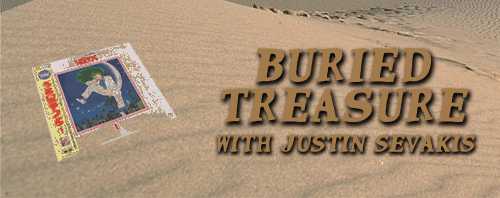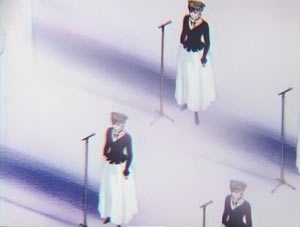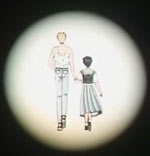Buried Treasure
To-y
by Justin Sevakis,
It's amazing how, in anime fandom, a show can attain near-Holy Grail status among a few hardcore fans and yet remain relatively unknown to everyone else. All it takes is a handful of people who are so passionate about a given title that they will stop at nothing to get it.
Take the 1987 OAV called To-y. Issued only once in 1987 (on LD, VHS, Beta and VHD), the laserdisc became an ultra-rare collector's item in the mid-90's, once a fansub was circulated. At one point, it's rumored that a disc was sold on eBay for US$6,000.
I was not (and am still not) of the means to spend $6,000 on a laserdisc of anything, but I counted myself as one of the faithful. And for ten years, I hoped to get my sweaty fanboy hands on it. I'm happy to report, I've finally succeeded. In a bizarre few months of coincidences and e-mail reunions, the damn thing practically fell in my lap. And then, something even cooler happened.

Special Edition: To-y (20th Anniversary Party!)
 In the summer of 1987, a teenaged boy named To-y and his band, "GASP", is about to make it big. At the same time, he gets an opportunity to leave his band behind, and become even bigger.
In the summer of 1987, a teenaged boy named To-y and his band, "GASP", is about to make it big. At the same time, he gets an opportunity to leave his band behind, and become even bigger.
Indeed, to the forces that want him, GASP will never be more than a blip on the radar. The world beckoning him is the world of pop stars, of prime-time concert TV shows, of screaming fangirls. GASP, meanwhile, is popular among the rebellious, the punks, the skaters, the motorcycle gangs. The sound is of the raw, sweaty variety. Though they've never released a record, the fans seem to be everywhere.
This bizarre culture clash comes to a head in the first scene of To-y. The popular idol singer of the moment, Yoji Aikawa, is at a GASP concert at the Shinjuku Loft (the Tokyo equivalent of New York's CBGB's). He's not enjoying himself. In fact, he's just sitting there. To-y, being something of a soft-spoken hot-head, is unnerved. He walks away from his microphone, approaches Aikawa, and delivers a hard punch to the cheek.
 This sets the tone for To-y's future dealings with the mainstream music industry quite well: he catches the eye of Aikawa's manager, a ruthless promoter named Ms. Kato. She approaches him, saying, "staying in that band is a mistake. You could probably be even bigger than Yoji Aikawa." To-y delivers a quick verbal slap to her pride ("I don't know who that is") and walks away.
This sets the tone for To-y's future dealings with the mainstream music industry quite well: he catches the eye of Aikawa's manager, a ruthless promoter named Ms. Kato. She approaches him, saying, "staying in that band is a mistake. You could probably be even bigger than Yoji Aikawa." To-y delivers a quick verbal slap to her pride ("I don't know who that is") and walks away.
GASP, meanwhile, is about to have the biggest concert of their careers, in a gigantic outdoor amphitheater in Hibiya. The concert will also be their first record. Tickets have been sold out for weeks. But the repercussions of To-y's actions against the industry have dire consequences, and the result may just break up the band.
It's a simple story, but To-y is more about the feeling, the environment, and the era than it is any actual story. The attention to detail is a window into the Japan of twenty years ago, from the tiny Coca-Cola Classic cans to the dusty bins of record shops. Punk fashions (most of which never materialized outside of Japan, such as pointy Witches' hats) dominate, along with super-detailed accounts of popular Tokyo hangouts, adorning the screen like it's a counterculture Ghibli movie. One unforgettable scene has one of the most vivid and joyous depictions of a Japanese street festival I've ever seen.
 But for all of the realism (punctuated with bits of what Nelly Furtado calls "the theatrical surrealism" of the MTV era), there is one odd character that doesn't fit the mold: To-y's pubescent female cat-girl sidekick Niya (voiced by 80's band Rebecca's lead singer Nokko). Her presence is jarring at first; she calls herself To-y's lover, dresses just like him (jeans and a loose tank-top), and prances about happily. To-y looks on with a quiet smile as if she were a hyperactive pet. Sometimes serving as comic relief (warding off the advances of To-y's sexpot cousin Sonoko, who's also a pop star under Ms. Kato), Niya is To-y's grounding force. She's there to remind us of the simple pleasures of To-y's life, and that anything more than happiness is really unimportant. Her disarming nature can immediately take the piss out of the most pretentious people, and diffuse the most awkward situations. Even as To-y is punching Aikawa in the face, he'll turn around when she calls, and grant her a smile.
But for all of the realism (punctuated with bits of what Nelly Furtado calls "the theatrical surrealism" of the MTV era), there is one odd character that doesn't fit the mold: To-y's pubescent female cat-girl sidekick Niya (voiced by 80's band Rebecca's lead singer Nokko). Her presence is jarring at first; she calls herself To-y's lover, dresses just like him (jeans and a loose tank-top), and prances about happily. To-y looks on with a quiet smile as if she were a hyperactive pet. Sometimes serving as comic relief (warding off the advances of To-y's sexpot cousin Sonoko, who's also a pop star under Ms. Kato), Niya is To-y's grounding force. She's there to remind us of the simple pleasures of To-y's life, and that anything more than happiness is really unimportant. Her disarming nature can immediately take the piss out of the most pretentious people, and diffuse the most awkward situations. Even as To-y is punching Aikawa in the face, he'll turn around when she calls, and grant her a smile.
For all his violence, To-y himself ends up something like Billy Budd -- a good-looking, charismatic young innocent, at once beloved to the point of obsession by those around him, and hated for his perfection by those in demonic authority. His refusal to be used by Ms. Kato and Aikawa is essentially killing Claggert, leading to accusations and the eventual fall of a peaceful existence with the rest of the band. But it's here where the parallels with Melville's story end. It's commonly accepted that Billy Budd is a reference to Jesus, and To-y is able to resurrect his dreams where Billy could not.
The manga, which runs ten volumes, goes on in a different direction, but for me the ending credits are the most moving part of the film. The "Big Ben" schoolbell rings, and we see To-y walking with Niya, who is now in a schoolgirl outfit. It's a subtle reminder that this was merely summer vacation; the enjoyable part of growing up, and that the difficulties of real life lie ahead for To-y (and everyone else). In this way, the film is an ode to the joy of being young, and the power of the idealism one has in dawn of one's adulthood. The anime chronicles one small triumph of a teenager against a cynical industry, and for all we know, there may never be another. Today, To-y would be in his 30's, but I'd like to think he still makes music.
 To-y was directed by Mamoru Hamatsu, who explored similar themes in Heroic Legend of Arlsan, and features gorgeous character work by Naoyuki Onda, whom I mentioned in my review of Nineteen19. Onda also handles animation direction, presiding over some absolutely astonishing moving-camera shots. (I'll never understand how they did that without computers.) The indescribably beautiful art direction is courtesy of Shichiro Kobayashi, whose arresting visual style has graced such anime as Utena, Loveless and Angel's Egg.
To-y was directed by Mamoru Hamatsu, who explored similar themes in Heroic Legend of Arlsan, and features gorgeous character work by Naoyuki Onda, whom I mentioned in my review of Nineteen19. Onda also handles animation direction, presiding over some absolutely astonishing moving-camera shots. (I'll never understand how they did that without computers.) The indescribably beautiful art direction is courtesy of Shichiro Kobayashi, whose arresting visual style has graced such anime as Utena, Loveless and Angel's Egg.
No mention of To-y is complete without speaking of the music, which plays like a best-of album of Japan's progressive pop scene. Manga artist Atsushi Kamijo became friends with many musicians during his research for the manga, and here such acts as ZELDA, The Street Sliders, and even Hajime Mizoguchi (Jin-Roh, Escaflowne, and Yoko Kanno's hubby) provide lush, if eclectic selections under the supervision of Masaya Matsuura. For the unfamiliar, Matsuura's band Psy•S was one of the late 80's and early 90's more experimental J-pop bands, and since then he's formed video game developer Nanaon-sha, and his games Parappa the Rapper and Um Jammer Lammy have become international best-sellers. (Several of his other awesome-looking rhythm games for PS2 have not been released stateside.)
For To-y, Psy•S' amazing opening and ending themes, Lemon no Yuuki and Cubic Lovers, are as essential to the show as the characters themselves. Never mind that Mami "Chaka" Yasunori's piercing female voice is what we hear when we see To-y open his mouth.. Just like the rest of the anime, it's the feeling that's important.
| Obscure-O-Meter™ | |
| A | Abundant. Available anywhere that carries anime. |
| C | Common. In print, and always available online. |
| R1 | US release out of print, still in stock most places. |
| R2 | US release out of print, not easy to find. |
| R3 | Import only, but it has English on it. |
| R4 | Import only. Fansubs commonly available. |
| R5 | Import only, and out of print. Fansubs might be out there. |
| R6 | Import long out of print. No fansubs are known to exist. |
| R7 | Very rare. Limited import release or aired on TV with no video release. No fansubs known to exist. |
| R8 | Never been on the market. Almost impossible to obtain. |
| Adapted from Soviet-Awards.com. | |
 As mentioned above, To-y is perhaps more known for its rarity than anything else. Trying to find the laserdisc is an exercise in futility... unless you get as lucky as I did...
As mentioned above, To-y is perhaps more known for its rarity than anything else. Trying to find the laserdisc is an exercise in futility... unless you get as lucky as I did...Thanks in part to an ANN forum post (thanks, Area88!) I discovered the fabled laserdisc listed on eBay. Luckily, declining interest in laserdiscs meant that the price barely broke $100. Boy, did I want this thing. I'm not what you would call a frequent eBay user, but I knew the tricks, and bid so hard and so furious in the last few minutes of the auction that I worked up a sweat!
I lost. By ten seconds and $2.50. I was heartbroken. And then, the planets must have aligned, because from that point on, the anime started wanting ME. The guy selling the LD turned out to be an old acquaintance from my days in the late 90's fansub scene; he had another copy and was planning to digitize it. Another old friend of mine I hadn't talked to in years saw the auction and offered it to me for the price it sold for. Overjoyed, I started assembling myself a neat DVD version, and started e-mailing some prominent To-y fans, trying to track down some of the music I was missing.
 This lead me to something I never would have expected: a fan restoration. Already underway for months was, to my knowledge, a first-of-it's-kind digital restoration, the sort classic anime is getting in japan these days, except performed entirely by old-school otaku. I was treated to an early look at the fruits of what had been a laborious process: countless hours of digital filtering and frame-by-frame retouching have resulted in a new version of To-y that looks as clean and pristine as if it had been animated yesterday. To-y was known for being one of the poorest quality LD's in anime history, so this is no small feat. A digisub version (with a new translation) was released a few days ago.
This lead me to something I never would have expected: a fan restoration. Already underway for months was, to my knowledge, a first-of-it's-kind digital restoration, the sort classic anime is getting in japan these days, except performed entirely by old-school otaku. I was treated to an early look at the fruits of what had been a laborious process: countless hours of digital filtering and frame-by-frame retouching have resulted in a new version of To-y that looks as clean and pristine as if it had been animated yesterday. To-y was known for being one of the poorest quality LD's in anime history, so this is no small feat. A digisub version (with a new translation) was released a few days ago.
Upon revisiting this new version, I was genuinely surprised at how much different the show felt. I hadn't noticed in the years spent watching my aging VHS fansub copy, but the washed-out colors and video problems I had taken for granted had affected my viewing in an imperceptible way: as a visual barrier between myself as the viewer, and the world of To-y. It felt more distant, the characters were harder to see into. The new version suffers none of these issues, and I found myself even more involved than I had even imagined. I'm not normally one that refuses to watch a poor quality copy of something, so this was something of a revelation to me.
 There is no hope To-y will ever get a domestic release, and fading hope of a Japanese one. As so many important musical acts are included in the program, music rights are thought to be a major issue to any re-release or international sales the show might have gotten. So therefore, this is one fansub in my collection that I will treasure as much as any hard-won import or rare commercial disc. It's something that fans achieved, through hard work and dedication, that would not have been possible any other way.
There is no hope To-y will ever get a domestic release, and fading hope of a Japanese one. As so many important musical acts are included in the program, music rights are thought to be a major issue to any re-release or international sales the show might have gotten. So therefore, this is one fansub in my collection that I will treasure as much as any hard-won import or rare commercial disc. It's something that fans achieved, through hard work and dedication, that would not have been possible any other way.
Fan restorations are a new by-product of the advances in desktop video in the last decade. There are many fan restorations online of everything from the original versions of Star Wars to the great unfinished animated classic "The Thief and the Cobbler," but the phenomenon has not been seen in the anime community until now. There are many fantastic, rare shows that will likely never see release again, in any country. For the sake of the art form, it's my sincere hope that we have not seen the last of the anime fan-restoration.

discuss this in the forum (28 posts) |